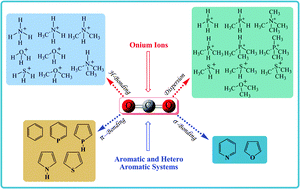Estimating the binding ability of onium ions with CO2 and π systems: a computational investigation†
Abstract
Density functional theory (DFT) calculations have been employed on 165 complexes of onium ions (NH4+, PH4+, OH3+, SH3+) and methylated onium ions with CO2, aromatic (C6H6) and heteroaromatic (C5H5X, X = N, P; C4H5Y, Y = N, P; C4H4Z, Z = O, S) systems. The stability of CO2⋯onium, CO2⋯π and onium⋯π complexes was shown to be mediated through various noncovalent interactions such as hydrogen bonding, NH–π, PH–π, OH–π, SH–π, CH–π and π–π. We have discussed 17 complexes wherein the proton transfer occurs between the onium ion and the heteroaromatic system. The binding energy is found to decrease with increasing methyl substitution of the complexes containing onium ions. Binding energy components of all the noncovalent complexes were explored using localized molecular orbital energy decomposition analysis (LMO-EDA). The CO2⋯π complexes were primarily stabilized by the dispersion term followed by contributions from electrostatic and polarization components. In general, for onium ion complexes with CO2 or π systems, the electrostatic and polarization terms primarily contribute to stabilize the complex. As the number of methyl groups increases on the onium ion, the dispersion term is seen to have a key role in the stabilization of the complex. Quantum theory of atoms in molecules (QTAIM) analysis and charges based on natural population analysis (NPA) in various complexes have also been reported in order to determine the nature of noncovalent interactions in different complexes.


 Please wait while we load your content...
Please wait while we load your content...